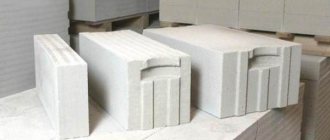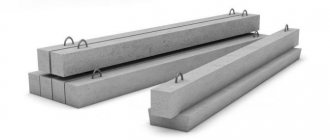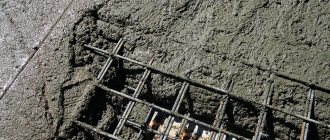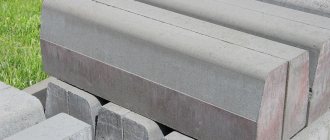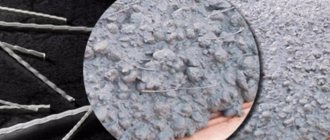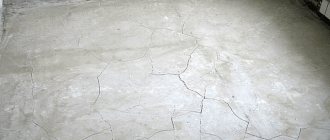In construction, the strength of a building is ensured by reinforced concrete structures of different shapes and sizes. Purlins are strong reinforced concrete beams that support floor slabs and absorb bending forces in wide openings. GOST 26992-86 imposes strict requirements for the manufacture of products and technical parameters; the regulatory standard is confirmed by accompanying documents issued by the manufacturer. You can buy reinforced concrete purlins in our Catalog.
Application area
The main task is performed by purlins; they provide reliable, stable support for the roof decks. In small buildings - residential buildings, administrative buildings, built of brick or block.
The construction industry uses reinforced concrete strong beams for its projects in order to:
- strengthen the opening - window, door, arched, balcony;
- ensure the stability of the roof;
- strengthen floor slabs and building frames in brick and block buildings;
- install garage or hangar doors;
- connect, as a connecting element, 2 parts of the building;
- serve as a supporting structure when covering a large room;
- create strength for the supports and rafter system;
- reduce the load when forming a technological recess or niche;
- simplify frame floors in small buildings;
- reduce load-bearing loads on floor slabs between floors;
- replace jumpers and crossbars if they are subject to increased loads.
In construction, different types of reinforced concrete purlins are used. Powerful long beams strengthen floors in the horizontal direction, thanks to their characteristic properties:
- increased strength;
- large weight, length;
- resistance in the area of bending loads.
The applied load is taken over by the auxiliary system, and the forces are distributed between load-bearing walls, trusses, and other supports.
Similar reinforced concrete products are divided according to characteristics and criteria, since reinforced concrete purlins have different dimensions, shape and even type of reinforcement.
Features of installation work
To understand how to fasten the rafters together, you need to correctly install the ridge girder. For this purpose, seats on the gables are pre-prepared in compliance with the horizontal level. Before laying, it is recommended to wrap the end parts of the prepared beam with waterproofing cloth. Next, the position of the support under the rafters is checked again and adjusted if necessary. You can use the building level and the equality of the diagonals along the slopes as reference points. Finally, you can begin fixing the beam.
An example of installing a beam on a block pediment Source obzorstroy.ru
Run enhancement methods
Vertical posts can be installed not only under nodal connections on a precast beam. They can be used as reinforcing elements that will take part of the bending load onto themselves and prevent the deformation process. In this case, the number of supporting elements depends both on the distance between the gables and on the cross-sectional dimensions of the ridge span. For a massive element, in addition to the racks, you can additionally mount struts.
The second option for strengthening the structure is to install so-called side girders. These are, as a rule, horizontally located additional beams that connect the rafter legs in their middle part. This reduces the load on bending and expansion of the rafters, and equalizes the pressure on the upper beam.
Classification by section
Each cross section of the purlin is named according to the type of profile:
- rectangular - looks like a pillar with notches;
- tee - along the end and cut, resembles the letter “T”, equipped with shelves on 2 sides on which the slabs rest or 1 shelf with an “L” shape.
Structures with a T-section are used in the construction of unheated premises or buildings in areas with increased seismic hazard.
Types of purlins
They are developed depending on the roofing structure, and are also divided into three types:
- ridge;
- sidewall;
- Mauerlat.
Ridge purlins are usually used to further support the roofing ridge. Support for the rafters in the form of an addition is carried out using side purlins, installed between a certain ridge, as well as its main component. A Mauerlat is mounted at the very rafter base along the entire upper part of the wall structure.
Classification by flange shape and type of reinforcement
Experts have created a table of sections, which includes standard jumpers and with various standard sizes. Products are classified according to the location of the flange to the rib of the beam:
- at a 900 angle - 1PR;
- perpendicular - 2PR and 3PR, group number depends on the reinforcement, used for roofs with a slight slope;
- at a small angle - 4PR and 5PR, used in the construction of roofs with a large slope.
Reinforcement of purlins can be:
- stressed, reinforcement is provided by steel reinforcement and rods;
- prestressed, the load-bearing capacity is increased by additional longitudinal metal rods.
Beams in buildings are installed taking into account the conditions of their use.
Nuances of calculating metal purlins
In the manufacture of open-profile wall purlins, calculations are used that are almost similar to those used in the production of roof purlins. In this case, the principles of mechanics of thin-walled structures described by V.Z. Vlasov, D.V. Bychkov are taken as a basis.
The difference between roof and wall beams lies in the loads, which in the latter case are placed on vertical and horizontal planes independently of each other. The wind horizontal load can be different and depends on the wind direction. This makes it difficult to select the desired section and its orientation, which would reduce the total normal stresses in the section, as is done when designing roof beams. By changing the direction of the horizontal load, the torsion of the structure can be increased or decreased. You can work in a similar way with other types of sections.
When performing calculations for wall beams, it is necessary to focus on the maximum possible effect of torsion on the stressed state of the beam section. When designing, one should proceed from the conditions of installation and further use of the structure.
Marking
Alphanumeric characters or run markings contain encrypted information. For example, the product is designated PRG 60.2.5-4. A400-1, which means:
- P – monolithic girder;
- R – support shelves;
- G – section view;
- 60.2.5 – purlin dimensions are indicated along the length, width and height in dm.;
- 4 – design load;
- A400 – class of steel used for reinforcement;
- 1 – applied a corner.
Labeling is used for the convenience of all consumers, sellers, and builders, so that they can immediately choose the right building material.
Main features of this type of structure
All purlins manufactured at factories of reinforced concrete products must comply with the standards of GOST 26992-86 “Reinforced concrete purlins for covering buildings of industrial and agricultural enterprises.” It is this regulatory document that determines what requirements each product must meet, and a number of indicators are regulated:
| Strength | The design load of the products must be at least 4,000 kgf/m, which allows the elements to be used in the construction of load-bearing walls. |
| Types of sections | There are two types of sections: rectangular and T-shaped. In construction reference books you can also find Z-shaped and C-shaped purlins, but they are a metal profile and are not used as elements of load-bearing structures. |
| Production material | The manufacturing material is heavy concrete grade M250, and for structures 6 meters long or more it is necessary to use the even more durable grade M350. |
| Reinforcement | There are two main options for reinforcement: unstressed, consisting of a spatial steel reinforcement frame, and stressed, consisting of prestressed reinforcing bars and a spatial frame. |
| Installation features | It is important to remember that the weight of the products is very large and it is unlikely that you will be able to carry out installation work yourself - you will need lifting equipment. It is for this reason that purlins are not often used in private development. |
Important! Do not confuse purlins with jumpers. Lintels are used for similar purposes, but are much smaller in size and are not designed for heavy loads and cannot be used in load-bearing systems. Purlins are suitable for any purpose: from strengthening openings (especially large ones) to creating additional strength in places where reinforced concrete slabs support.
Purlins are much larger and more massive than jumpers
Technical specifications
Each reinforced concrete product has a number of technical characteristics that indicate the characteristics of the beam, reveal the properties and main parameters:
- rectangular or T-section;
- concrete grade and material for reinforcement and strengthening;
- design load;
- purlin dimensions;
- product weight.
Based on the data specified in the accompanying document, the builder selects the required products.
Reinforced concrete slab lintels are also used as purlins.
Purlins in the form of grids and solid components
In the tank plant they are produced in only a few types, these are solid and also lattice, they are also called through. Although in other industries they are trying to increase the options and, according to modern technologies, the types of metal structures receive a more advanced design.
- The purlins (solid origin) are made from a rolled channel consisting of a bent profile of the Z and C models. The entire upper structure of the lattice models is presented as a conventional horizontal belt. But the lower structure is made in the form of a broken or even triangular belt, consisting of special angles, including channels. Usually, lattice-shaped ones are considered heavier than solid ones, which is why they are best used in frame structures with a distance of trusses of no more than 6 meters.
- Solid metal frame purlins are divided into several main types: cut and continuous. The first option in the form of continuous purlins is used most often, only because this form is much easier to produce during installation, and also evenly divides the entire load between the trusses.
The second type is usually used when constructing pitched roofs . For this system, a certain load is usually created symmetrically to the slope. In order to increase the rigidity of the roof structure, they are attached using metal weights, this completely reduces the number of all spans. If you maintain a distance of 6 meters between the trusses, they are mounted in the same row, located between the main purlins. With an increase in the distance between trusses or in roofs, rounded weights can be mounted in several rows, or rather only in two rows.
Steel purlins made from LSTK profile with a lattice section are equipped with a reinforced structure. Due to this, they are able to react during compression of bends, as a result they perceive only longitudinal loads simultaneously with others.
But the production of this design has a significant drawback, and this is that:
- the component is made of several structures;
- installation work requires huge labor costs as well as energy consumption.
Thanks to this, the optimal method for creating rack-mount lattice models turns out to be a purlin in the form of three-panel structures, where there are top chords (where there are two main channel frame beams), lattices (as single bent-shaped channels), as well as braces.
They are particularly used in agriculture, warehouses, hangars, sports facilities, shopping centers, shops, workshops and so on.
Installation features
Reinforced concrete beams are installed in the following order:
- in accordance with the design documentation, they comply with the step that is approved for the main load-bearing and inclined structures;
- moved and lifted using special equipment, having previously secured it;
- the work is carried out by builders of 4 people;
- laid horizontally, the wall serves as a support to lay a slab on top or build a roof.
Installation of purlins is carried out in stages in compliance with technological standards.
Transverse devices belong to reinforced concrete products, important elements on which the entire structure rests. This reliable lintel provides the building with guaranteed strength and increases its service life.
Purpose
Reinforced concrete purlins are used in construction to solve an important problem. For example, not a single opening can be made without using a purlin. Only after its installation are the floor slabs attached. And reinforced products made under the influence of heat treatment can withstand heavy loads. They are used in the construction of public and industrial buildings with brick and reinforced concrete walls. Most often they are used in the construction of openings, supports on which floor slabs are attached.
Installation of the purlin: a) view of the support on the wall; b) on a pole; 1. reinforced concrete pad; 2. runs.
Reinforced concrete purlins are prepared exclusively in an industrial manner, in accordance with state construction standards. For their production, only heavy concrete is used, most often M200 and M300, with the use of reinforcement for reinforcement. The use of structures in favorable conditions increases the service life of buildings.
Return to contents
